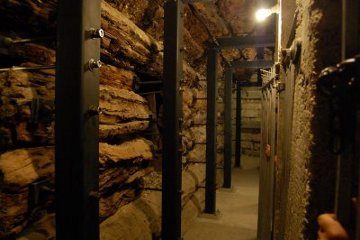A Healthy Diet
As a life-long vegetarian, I have long known that the vegetarian diet was good for you, helping you remain healthier than your non-vegetarian counterparts as well as being more ecologically sound. It now appears that a vegetarian diet has many of the same benefits for the afterlife as it does for the present life.

| |
| The huge timbers on the left make up the burial chamber of the tomb of Midas. The earth has been cut away so that tourists can walk round the chamber. |
Archaeologists have long been puzzled over the extensive decay in the tomb of King Midas, at Gordion in Turkey. Midas was buried beneath a huge tumulus or mound of earth on the outskirts of his capital city. The actual tomb itself, however, consisted of a room built from massive juniper logs and lined with pine wood. Juniper is decay resistant, as is the cedar wood used to make the royal coffin. Cedar wood in the Gizeh boat, for example, is still in a good state of preservation.
However when archaeologists excavated the tomb in 1957, they found an unusual soft-rot fungus that had wreaked extensive damage to the wood in the tomb. Even the huge logs that made up the outer wall of the tomb chamber were in a dangerous condition, and the inlaid furniture with which the tomb was provided was in a very parlous state indeed.
It was known that the particular fungus responsible flourished in dry conditions and archaeologists just assumed that the tomb chamber had remained extremely dry under its huge covering of earth and left it at that, but increased knowledge about the fungus has cast doubt on the sufficiency of dryness as an explanation. The fungus requires nitrogen in order to flourish - so where did the nitrogen come from?
One source, of course, would be King Midas. As the human body decayed, it would release a certain amount of nitrogen - and as only bones were found in the tomb, it was obvious that Midas' body had well and truly decayed. Timothy Filley, of Purdue University, analysed nitrogen isotope concentrations in samples taken from various locations in the tomb and declares, "Analysis of samples from the floor around the coffin shows the spreading of the king's nutrients through the tomb."
There is, however, another possible source. Buried along with the king were a large number of bronze and pottery vessels containing the remains of the funerary feast held in the king's honour. These remains have been analysed and form the basis of the King Midas feasts that the tourists enjoy. The point is that much of the meal was meat - which would also have provided food for the fungus as it decayed.
Filley and his team examined samples taken from around the coffin and the table in the tomb and found them high in nitrogen-15. It appears that creatures high up in the food chain have high levels of nitrogen-15 (probably for the same reason that DDT accumulates to high levels in predators; the creatures they eat have low levels of DDT, but by eating lots of these dead animals, carnivorous creatures accumulate DDT and build up a high level in their own bodies.)
Interestingly, wood in the tomb which was not attacked by the fungus was found to have low levels of nitrogen-15. We may assume, then, that the wood which was infected had somehow been covered with decay products from the king's body and the bodies of the animals his mourners had eaten.
Levels of nitrogen-15 from around the coffin were still sufficiently elevated that Filley speculates that Midas, as a high status individual, may have eaten a high-meat diet, thereby accumulating more nitrogen-15 in his body than normal. It is ironic to think that the diet the king had been able to afford during life, should have negated the provisions of the tomb he was able to afford in death.





